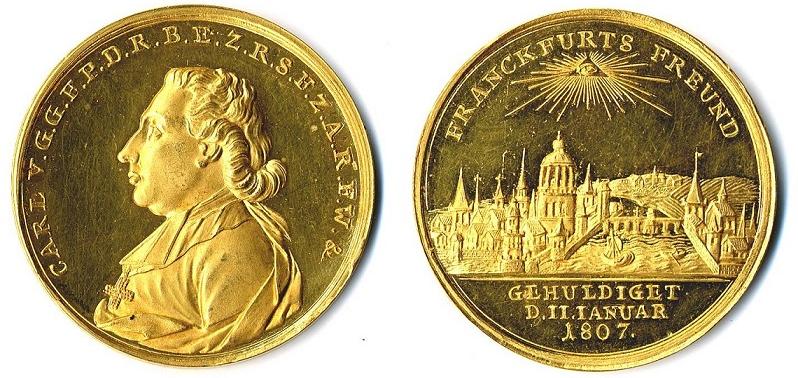
Collection – Numismatics
The coin collection of the Historisches Museum is unique in Germany. Greeks and Romans, the Middle Ages and the modern era, medals and bank notes – all give an overview of the development of our money through to the euro.
It all began in 1749, the year that Goethe was born. Widow Elisabeth Katharina von Barckhaus bequeathed 3,296 Greek and Roman coins to the city. Today, this collection has grown to more than 150,000 pieces thanks to purchases and donations. The Frankfurt division contains examples of practically every coin or bank note minted in Frankfurt. They span from the introduction of the pfennig in Frankfurt by Charlemagne to the introduction of the euro. As well as this, there is a large collection of medals awarded to Frankfurt events and people of Frankfurt. Imprints of Frankfurt imperial coronations and the historic records of Johann Wolfgang Goethe are focal points of the medals. A larger range of dies sheds light on the production process of Frankfurt coins and medals.The considerable coin collection contains minting from all mints in Germany. It was acquired by Frankfurt merchant Ernst Lejeune in 1939 and was the most significant private collection of German coins in the world. The emphasis is on the Rhine-Main area, with excellent series of coins from Hesse, Hanau, Friedberg, Mainz, Solms and Sayn (of the Holy Roman Empire). The collection of paper money consists of notes from the German Empire as well as emergency and inflation notes from counties, communes and companies. Marks, tokens, awards, orders, buttons and pins can all be found in the section on everyday culture.
The current themes of the coin collection focus on Frankfurt as a European financial hub. On the one hand, it takes its tradition from the Frankfurt fair (founded in 1241) and the local coronations; on the other, from the role of the Frankfurt Stock Exchange and the financial innovations that have arisen from over the past centuries.
Collection catalogue
Gisela Förschner, Papstgeschichte auf Medaillen. Historiae o. sacrum decus. Frankfurt am Main, Historisches Museum, 1978. 63 p., Ill. (Kleine Schriften des Historischen Museums Frankfurt. Vol. 11)Gisela Förschner, Kleinkunst in Silber. Schraubtaler und Schraub-Medaillen. Frankfurt am Main, Historisches Museum, 1978. 75 p., Ill. (Kleine Schriften des Historischen Museums Frankfurt. Vol. 10)
Gisela Förschner and Franz Lerner, Frankfurter Geld vor 400 Jahren. Frankfurt am Main, Historisches Museum, 1980. 75 p., Ill.
Gisela Förschner, Goethe in der Medaillenkunst. Historisches Museum Frankfurt am Main. Melsungen, Gutenberg, 1982. 343 p., Ill. (Kleine Schriften des Historischen Museums Frankfurt. Vol. 16)
Gisela Förschner, Glaspasten, geschnittene Steine, arabische Münzgewichte. Sammlungen des Münzkabinetts aus dem bürgerlichen Bildungsgut des 19. Jahrhunderts in Frankfurt am Main. Historisches Museum Frankfurt. Melsungen, Gutenberg, 1982. 111 p., Ill. (Kleine Schriften des Historischen Museums Frankfurt. Vol. 15)
Gisela Förschner, Die Münzen der Kelten. Historisches Museum Frankfurt am Main. Melsungen, Gutenberg, 1983. 88 p., überw. Ill. (Kleine Schriften des Historischen Museums Frankfurt. Vol. 18)
Gisela Förschner, Deutsche Münzen. Mittelalter bis Neuzeit der münzprägenden Stände von Aachen bis Augsburg. Band 1 (mehr nicht erschienen). Historisches Museum Frankfurt am Main, Münzkabinett. Melsungen, Verl. Gutenberg, 1984. 281 p., Ill.
Gisela Förschner, Die Münzen der Griechen in Italien und Sizilien. Die Bestände des Münzkabinetts. Historisches Museum Frankfurt am Main. Melsungen, Gutenberg, 1986. 230 p., Ill. (Kleine Schriften des Historischen Museums Frankfurt. Vol. 27)
Gisela Förschner, Die Münzen der römischen Kaiser in Alexandrien. Die Bestände des Münzkabinetts. Frankfurt am Main, Historisches Museum, 1987. 455 p., Ill. (Kleine Schriften des Historischen Museums Frankfurt. Vol. 35)
Gisela Förschner, Frankfurter Krönungsmedaillen aus den Beständen des Münzkabinetts. Frankfurt am Main, Historisches Museum, 1992. 557 p., Ill. (Kleine Schriften des Historischen Museums Frankfurt. Vol. 49)
Gisela Förschner, Geldumlauf im Frankfurter Raum von 1572 bis 1697. Ein Münzschatzfund aus Ober-Wöllstadt aus den Beständen des Münzkabinetts. Frankfurt am Main, Historisches Museum, 1995. 183 p., Ill. (Kleine Schriften des Historischen Museums Frankfurt. Vol. 51)
Hans-Christoph Noeske, Die Münzen der Ptolemäer. Die Bestände des Münzkabinetts. Historisches Museum Frankfurt am Main, 2000. 189 p., Ill. (Schriften des Historischen Museums Frankfurt. Voö. 21)
Werner Helmut Stahl, Frankfurter Marken und Zeichen. Frankfurt am Main, Historisches Museum, 2004. 807 p., Ill. (Schriften des Historischen Museums Frankfurt. Vol. 24) Werner Helmut Stahl, Marken und Zeichen des 14. bis 19. Jahrhunderts, Frankfurt 2012. 526 p., Ill.

